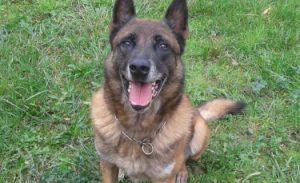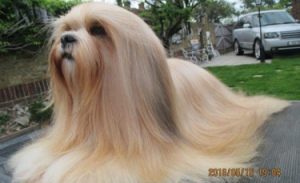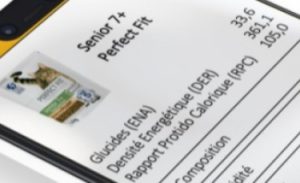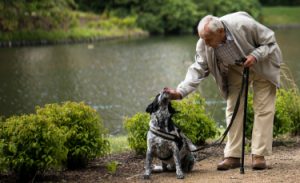Other name: Sabueso Espanol
The Spanish Hound is a medium-sized, slender dog, the length of its body greatly exceeding its height at the withers. The Spanish Hound is particularly recognizable by its very long floppy ears and its considerably developed thoracic perimeter. This compact, bony dog has strong, relatively short limbs.
<!–
–>
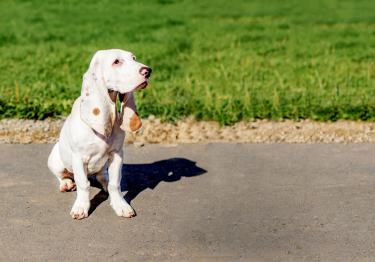
| Short | |
| Spain | |
| Average | |
| Long |
| Sex | Weight | Cut |
|---|---|---|
| Female | From 24 kg to 25 kg | From 48 cm to 53 cm |
| Male | From 24 kg to 25 kg | From 52 cm to 57 cm |
History of the breed
As its name suggests, the Spanish Hound originates from Spain , where it distinguished itself very early on with hunters . The breed of the Spanish Hound has existed since the 14th century in the hunting literature, because the king Alfonso XI of Castile (1311-1350) mentions it in his book of hunting. It will be the same for the historian Gonzalo Argote de Molina (1548 – 1596), who mention the 16th century in his writings.
Spanish Hound Pictures
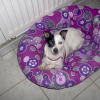
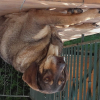

View all Spanish Hound photos of Woopets members
Physical features
His hair: short, rather fine, tight, lying, of uniform length and texture over the whole body, even between the fingers.
Its color: two-tone white and orange, characterized by well-defined irregular spots without speckles.
His head: in proportion to the rest of the body, rather long and harmonious. The skull is moderately large (more in the male than in the female). Seen in profile, it is convex. Seen from the front, it is domed. The stop is gently sloping and very moderately marked. The nose is large, moist and the nostrils are wide open. The muzzle is straight. The upper lip covers the lower one, which forms a marked labial commissure. The jaws are articulated in scissors.
His ears: very long, drooping, large, rectangular in shape with a rounded end. Flexible, they are attached below the eye line.
His eyes: medium-sized, almond-shaped, hazelnut in color, displaying an expression that is at the same time intelligent, sad and noble.
His body: much longer than tall, strong and robust. The thoracic perimeter exceeds by one third the height at the withers. The topline is straight, the back slightly concave, the kidney moderately convex, broad and raised, the withers advanced and slightly marked. The croup is strong, broad, rather horizontal. The chest is well developed, broad, well let down. The ribs are rounded, the belly slightly raised and the flanks ample.
Its tail: attached moderately high, thick at its base, covered with a short hair ending in a brush. Carried slightly curved at rest, rising slightly into a saber when the dog is in action.
Behavior and character
| Affectionate | |
|---|---|
| Calm | |
| Protective | |
| Independent | |
| Hunter | |
| Barks / howls |
Behavior with others
| Cohabitation with children | |
|---|---|
| Sociable with other animals | |
| Love strangers |
The Spanish Hound is particularly effective in blood tracking. It specializes in small game, mainly hare, but it can also show itself to its advantage with big game: wild boar, deer, roe deer, bear, fox … Courageous and determined in hunting , the Spanish Hound gives of the voice to guide his masters. In family, he is full of affection and has a rather calm temperament .
The Spanish Hound
is it right for you? Take the test!
Education
| Clever | |
|---|---|
| Obedient |
The education of the Spanish Hound remains fairly straightforward . Even if obedience is not his strong point, it only requires a minimum of firmness to integrate the basics of learning. His attachment to his master and his willingness to work facilitate his education. The reminder should be instilled in him as soon as possible.
Living conditions
| Suitable for apartment living | |
|---|---|
| Good for new masters | |
| Love it hot | |
| Love the cold |
The Spanish Hound is not very comfortable in an apartment. He much prefers living in the countryside , as dictated by his strong hunting dog heritage. However, it can adapt to an urban lifestyle by being regularly and for a long time.
Health
| Solid | |
|---|---|
| Ease of gaining weight |
The Spanish Hound is characterized by its robust constitution . He enjoys good health and no disease predisposition peculiar to this breed is attributed.
Hypoallergenic breed
No
Litter size
Between 4 and 6 puppies
| Major concerns |
|
||
| Minor concerns |
|
| Occasional concerns |
|
|
| Suggested tests |
|
To protect you from these risks and insure your companion in the event of health problems, Woopets recommends a Spanish Hound dog insurance .

function showAssuranceForm () {var siteReferer = var id_race_association = ”; //console.log(id_race_association);success: function (html) {}});}document.addEventListener (‘DOMContentLoaded’, () => {$ (‘# assuranceModalBanner’). on (‘show.bs.modal’, function (event) {showAssuranceForm ();});});
Life expectancy
Minimum: 10 years
Maximum: 12 years
The life expectancy of a Spanish Hound is, on average, between 10 years and 12 years.
Calculate the human age of your Spanish Hound!
To choose… 1 year 2 years 3 years Four years 5 years 6 years 7 years 8 years 9 years 10 years 11 years old 12 years 13 years 14 years old 15 years old 16 years old 17 years 18 years old 19 years old 20 years 21 years old
Maintenance and hygiene
| Ease of maintenance | |
|---|---|
| Cost of maintenance | |
| Hair loss |
| Drool level | |
|---|---|
| Ease of grooming |
The Spanish Hound is easy to care for .
It is recommended to brush the dog once or twice a week to get rid of dead hair. Its hair, ears , eyes and pads should be examined after each outing in the wild to detect and remove any debris or external parasites.
His teeth need to be brushed frequently to remove tartar build-up and the proliferation of bacteria. Finally, if they do not wear out naturally, its claws need to be cut. If you are new to this, it is recommended that you seek advice from a veterinarian or groomer.
Price and budget
Purchase price
Mini
NC Maxi
NC
The purchase price of a Spanish Hound is between NC and NC.
Annual maintenance cost
Mini
€ 450 Maxi
650 €
The annual maintenance cost of a Spanish Hound is between € 450 and € 650.
No name is currently proposed. Use our tool to find the name of your Spanish Hound!
Food
The Spanish Hound needs a balanced, high-quality diet (such as high-end kibble), adapted to his level of physical activity, size and age. Its food is to be divided into 2 meals per day . During the hunting season, it is advisable to adjust your rations upwards, then to return to the usual quantities once it is over.
Want the best for your dog?
Create the tailor-made diet for your Spanish Hound
I discover !
PROMO -30% | Delivered to you!

Physical activity
| Athletic | |
|---|---|
| Energy level | |
| Potential to play |
The Spanish Hound has a moderate need for exercise . It is not necessary to subject it to intensive activities, but it simply calls for long walks , ideally in the middle of nature.
Competitions
| Classifications & Standards |
|
Others
| Master character <span class="btnTooltip qTip2" title="- Calm: the master must be gentle and know how to show patience. – Active: the owner must be energetic and dynamic to live in harmony with his dog. – Hyperactive: the owner must be stimulating and very restless to suit the temperament of his dog.”> |
Active |
|---|
We talk on the forum
When my dog does his heavy needs, he runs away. Why ?
Guest message
bam the dog now bam the dog’s revenge
Message from angeacorne
Amazing – a dog saves another dog
Message from Joo
My dog has doggy breath!
Message from Jérôme Bernier
My dog got into a fight with another dog and he got hurt …
Message from Nicole
Do you have a question about the Spanish Hound?
Do not hesitate to ask Woopets visitors for advice on the forum!
FCI Information
FCI No.
204
FCI Group
Group 6: Hounds, Blood Test Dogs and Related Breeds
Recognized by FCI
Since 1957
</div




